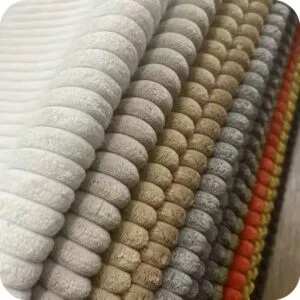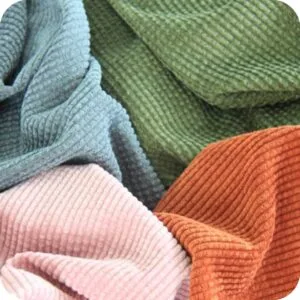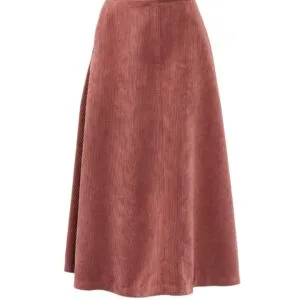
Corduroy fabric is a unique and versatile textile that is instantly recognizable due to its distinctive texture, characterized by its parallel ridges or “wales.” These ribs give the fabric a soft, velvety feel and make it an attractive and durable option for various clothing and home textile applications. Corduroy has a rich history dating back several centuries, and over time, it has evolved to become one of the most popular fabrics in fashion, particularly in autumn and winter collections.
In this article, we will explore what #corduroyfabric is, the different #fabrictechniques used to create it, its numerous benefits, and the wide range of applications for which it is ideal. Additionally, we will examine some sources like #fabrics-fty.com and #textile-fty.com that provide premium quality corduroy fabrics for different industries and design needs.
Corduroy is a #wovenfabric with a distinctive pattern of raised “cords” or ribs that run vertically along the fabric. The ribs are formed by weaving extra sets of fibers into the fabric, which are then cut and brushed to create the characteristic texture. The number and width of these ribs can vary, giving different types of corduroy their unique appearance.
The fabric’s origins can be traced back to ancient Egypt, but the modern version of corduroy as we know it today gained popularity in the 19th century, particularly in Europe and the United States. Originally made from #cotton, corduroy was primarily used for working-class clothing because of its durability and warmth. Over the years, it has evolved into a high-quality, fashion-forward fabric that is now widely used in both casual and formal clothing.
Corduroy is often made from #cottonfibers, although variations exist that incorporate blends with other materials, such as #polyester, #linen, or #wool. The wide range of materials used allows corduroy to cater to various preferences in terms of feel, appearance, and durability.
The production of corduroy fabric involves several steps, and various techniques are used to give the fabric its signature texture and finish. These techniques differ depending on the type of corduroy being produced, whether it’s a fine-wale corduroy or a wide-wale version.
1. Weaving
The first step in making corduroy fabric is weaving. In this process, extra yarns are woven into the fabric to create the raised texture. These extra yarns, known as pile yarns, are woven over and under the base fabric, and once the fabric is finished, these yarns are cut to create the ribbed effect.
Corduroy can be made using different types of weaves, including the plain weave or a more complex twill weave. The #weavingtechnique used will determine the density, width, and overall appearance of the ribs. The finer the weave, the closer together the ribs will be, and the more delicate the corduroy will feel. Conversely, a coarser weave results in wider ribs and a more rugged texture.
2. Raising and Shearing
After the fabric is woven, the next step is raising and shearing. Raising is a process where the fabric’s pile yarns are lifted and brushed to create the soft, velvety texture that corduroy is known for. Shearing involves trimming the pile yarns to a uniform length to ensure that the ribs are consistent in height.
The raising process is particularly important because it enhances the fabric’s tactile qualities, making it softer and more comfortable to wear. The shearing process ensures that the ribs are well-defined, creating a crisp, clean look on the fabric’s surface.
3. Finishing and Dyeing
Once the fabric has been woven, raised, and sheared, it undergoes a finishing process. This may include various treatments such as dyeing, heat setting, or applying softeners to improve the fabric’s texture and durability. Corduroy is typically dyed in a wide range of colors, from classic earthy tones like #brown, #navy, and #olive to more vibrant hues. The dyeing process can also affect the overall texture, enhancing its depth and luster.
For some types of corduroy, additional finishing treatments are applied to give the fabric extra resistance to wear and tear, as well as to improve its overall longevity. These treatments may involve the application of a water-repellent finish, flame-retardant coatings, or antimicrobial treatments, depending on the intended use.
4. Type of Corduroy Fabric
There are several different types of corduroy fabrics, which vary in terms of the size and number of ribs (known as “wales”). These variations provide different aesthetic and functional characteristics.
•Wide-wale Corduroy: This type of corduroy has thicker and fewer ribs, creating a bold, textured look. It is often used for more casual garments and is typically heavier in weight.
•Fine-wale Corduroy: Fine-wale corduroy has narrower ribs, giving it a more delicate and refined appearance. It is often used for formal or semi-formal clothing, such as blazers or dress pants.
•Pincord Corduroy: This type of corduroy has very fine, close-knit ribs and is typically lighter in weight. It has a smooth and subtle texture, ideal for sophisticated garments
Corduroy fabric is appreciated for its combination of durability, warmth, and texture. Below are some of the key benefits of using corduroy fabric in various applications:
1. Durability
Corduroy is known for its strength and durability. The raised ribs, combined with the fabric’s dense weave, make it a highly robust material that can withstand everyday wear and tear. This makes it ideal for clothing items that see frequent use, such as trousers, jackets, and overalls.
In addition to its strength, corduroy is resistant to abrasions and holds up well over time, maintaining its quality and appearance after repeated washes and wear.
2. Comfort and Warmth
Corduroy fabric is soft to the touch, especially fine-wale corduroy, which gives it a comfortable, almost velvety feel. The texture of the ribs also helps trap heat, making corduroy an excellent choice for cooler weather. This characteristic makes it a popular fabric for autumn and winter garments, providing warmth without sacrificing style or comfort.
3. Versatility
Corduroy fabric is versatile and can be used in a variety of applications. Whether for casual, workwear, or formal attire, corduroy offers a unique look that works well for different styles. It can be used for jackets, pants, skirts, dresses, and accessories such as hats and bags. It also performs well in home décor, with corduroy being a popular choice for upholstery and curtains.
4. Timeless Appeal
Corduroy has a timeless appeal that transcends trends. Whether used in classic tailoring or modern streetwear, corduroy remains a fabric that never goes out of style. It has a vintage, nostalgic quality, yet its versatility allows it to be used in both contemporary and traditional designs.
5. Eco-Friendly Option
As a natural fiber-based fabric, corduroy made from cotton or wool is an eco-friendly alternative to synthetic textiles. Furthermore, #sustainablepractices in fabric production, such as organic cotton, have made corduroy even more environmentally friendly.
Applications of Corduroy Fabric
Corduroy’s unique qualities make it suitable for a wide range of applications. Below are some of the most popular uses for this versatile fabric:
1. Apparel
Corduroy is predominantly used in the fashion industry, where it is a popular choice for both casual and formal garments. Items such as corduroy pants, jackets, skirts, and shirts are staples in many wardrobes. Fine-wale corduroy is often used for smart blazers or tailored pants, while wide-wale corduroy is preferred for more casual, rugged designs.
2. Home Décor
Corduroy also plays a significant role in home décor. Its plush, textured surface makes it ideal for use in upholstery, particularly for sofas, chairs, and cushions. The fabric’s warmth and durability also make it a popular choice for curtains, bedding, and throw blankets.
3. Workwear
Due to its durability and comfort, corduroy has long been a favored fabric for workwear. It is commonly used in the manufacturing of durable jackets, pants, and overalls for workers in various industries, including agriculture and construction.
4. Accessories
Corduroy is also used in accessories such as hats, bags, and scarves. The fabric’s textured surface can add visual interest and style to any accessory, making it a great choice for fashion-forward designs.
5. Children’s Clothing
Corduroy’s softness and warmth make it a great fabric for children’s clothing. Its durability ensures that it can withstand rough play, while its cozy texture keeps kids comfortable in cooler weather.
Conclusion
#Corduroyfabric is a timeless and durable material with a rich history, offering a unique combination of texture, comfort, and versatility. With various weaving and finishing techniques, corduroy can be tailored to suit a wide range of applications, from fashion and workwear to home décor and accessories.
Whether you are a designer, manufacturer, or consumer, the wide range of corduroy fabrics available, such as those offered at #fabrics-fty.com and #textile-fty.com, ensures that you can find the perfect fabric for your project. With its durability, comfort, and visual appeal, corduro
#FreeWaterproofFabric #PUCoatingFabric #JacquardFashionFabric #MilkyPUCoating



